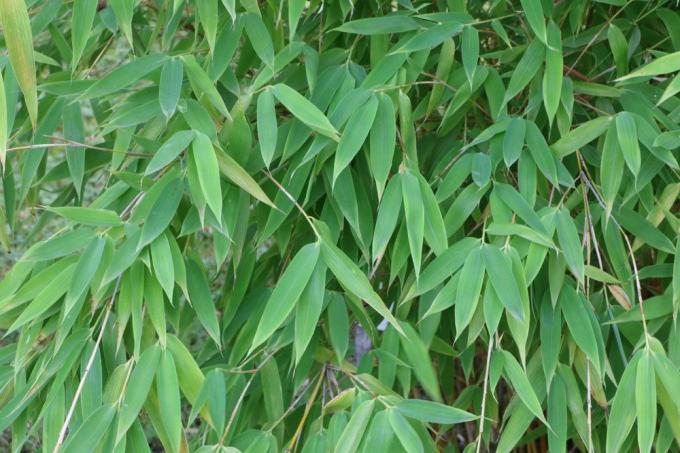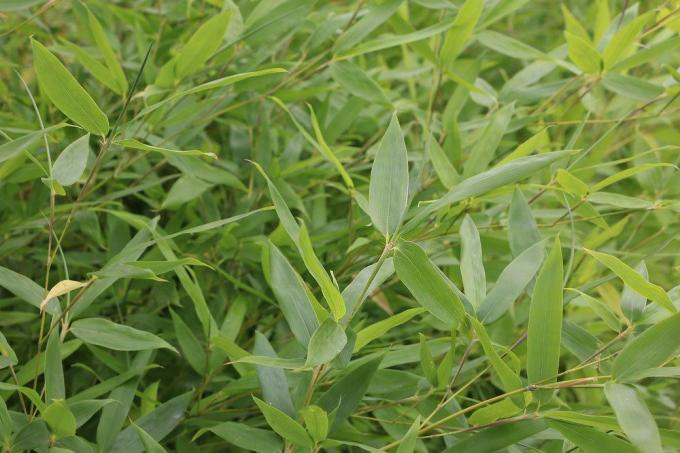
table of contents
- Bamboo hedge
- Location
- floor
- Planting time
- Plant spacing
- plants
- Bamboo varieties for a hedge
Bamboo hedges are becoming more and more popular in Germany because the hedges are very quickly opaque. In addition, bamboos are easy-care plants and bring an exotic flair to the garden. There is one small disadvantage, however. The hedge should be planned well, because some types of bamboo grow very expansively.
Bamboo hedge
Planning a bamboo hedge depends largely on which bamboo you want to plant. Since, according to German courts, bamboos are ornamental plants, even though they are botanically considered come from the sweet grass family (Poaceae), you have to comply with the relevant legal requirements note. This applies above all to Article 47ff BGB and the state law on neighborhood law.
In addition, if you plan to plant a tall bamboo hedge, it is important that you bear in mind that the stalks that move in the wind can damage walls and buildings. Therefore, you should plan at least the maximum growth height of the bamboo as the distance to the hedge. As evergreen grasses, there is still a risk that they will rain and
snow can become an obstacle on roads and paths.tip: The overhanging and swinging out of the stalks can be contained with a bamboo stand or a stretched string. impede.
Location
Since the location is usually predetermined when creating a bamboo hedge, the choice of bamboo type depends on the hedge location. However, this is not a problem, because the right bamboo can be found for almost every location. However, you will not be happy with a bamboo hedge if the plants are not protected from north and east winds. Because bamboo, like draughty locations in general, does not tolerate these cold winds well.
floor
Although the bamboo does not make any special demands on the soil, it prefers one
- humous
- casual and
- permeable
Soil. But it can also cope with heavy or sandy soils. Only compacted soils cause problems for the bamboo, as there is a risk of waterlogging, which the plant cannot tolerate at all. In this case it helps to loosen the soil and / or create a drainage system.
Planting time
You can create bamboo hedges from early spring to late autumn, with spring being the ideal time of year. The advantage of spring planting is that the bamboo has a lot of time to get used to, namely a complete vegetation period. If the hedge is created in summer, the young bamboo plants need a very good water supply. If the bamboo hedge is planted in late autumn, protection against extreme cold is necessary in the first winter.
Plant spacing
The planting distance for bamboo hedges depends on the size of the plants supplied, because a wider distance must be chosen between larger bamboos than between smaller ones. When measuring the planting distance, you can use the following guide values as a guide:
- Containers under 7.5 liters: two to three bamboo plants per meter
- Containers with more than 10 liters: plan 70 to 100 centimeters between the plants
Alternatively, you can also use the amount of the purchased or To set up the bamboo plants to be bought:
- just under a meter: a maximum of 70 centimeters
- from 40 to 70 centimeters: 25 to 30 centimeters
- over two meters: 100 centimeters
The mentioned distances refer to bamboo hedges, which are opaque after the third vegetation period. If the hedge is to be opaque as soon as it is set, then plant bamboos with a height of two meters with a planting distance of 50 centimeters.
plants
To ensure that the distances between the grasses are correct, it is advisable to first set them up above ground in the planned location. If everyone is correct, then the setting of the bamboo hedge begins:
- Dig the planting hole
- Pour in a ten centimeter thick layer of compost and garden soil
- Size: twice the diameter of the root ball
- Planting depth: the upper area of the root ball is flush with the surface of the earth
- Fill in the planting hole
- Press the earth lightly
Once all the bamboos have been planted, the entire planting area is extensively watered. This so-called Sludging prevents the formation of air holes and causes all roots to come into contact with the soil.

Tip: Since you will probably have to provide the hedge with additional watering, for example in winter, you should create a watering edge. This occurs when the filled soil is below the garden soil.
A slightly more complex method of planting the hedge is to dig a planting trench instead of many holes. This has the advantage that the soil is nice and loose over the entire course of the hedge and the water can be better distributed.
tip: The mulching of bamboo hedges is not recommended, as the nitrogen consumption is high when the mulch decomposes, and the nitrogen required for growth is thereby removed from the bamboo.
Bamboo varieties for a hedge
The following types of plants are particularly suitable for planting a bamboo hedge:
- Fargesia
- Pseudosasa
- Phyllostachys
The species Fargesia murielae is particularly popular because it does not form runners and is convincing with its very good winter hardiness (USDA zone 6 = -23.4 ° C to -17.8 ° C). The height of the different varieties of Fargesia murielae averages between 100 and 400 centimeters. The growth width varies on average between 100 and 250 centimeters. Some varieties, such as Fargesia murielae “Maasai”, have an upright, columnar habit, while others, such as “Standing Stone”, grow overhanging. Also with the color of the leaves or You can choose straws. It is therefore best to inquire about the growth characteristics and requirements of Fargesia murielae in specialist shops.




